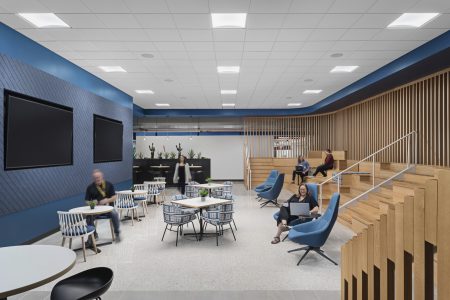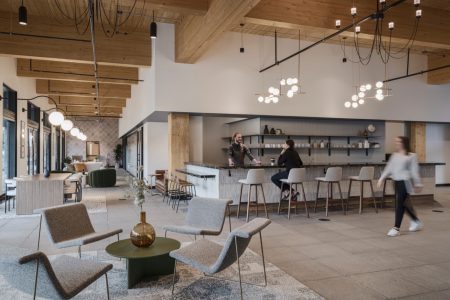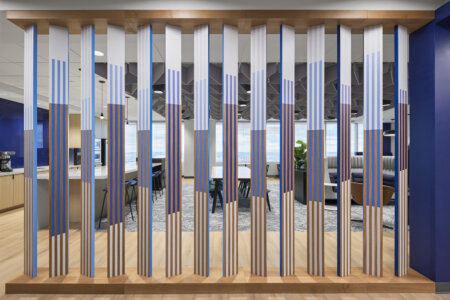The Realities of Returning to the Office

RSP’s David Serrano explains lessons learned from the first wave of employees returning to the office and how to embrace company culture in a new way.
*This article was originally published in Work Design Magazine.
Companies have made their decisions. Policies have been written. Lines have been drawn in the sand. Whether organizations are going for a hybrid model (most of our clients), fully remote or totally in person, the first wave of employees has been testing out post-pandemic workplace strategies for several months.
As workplace designers and strategists, the biggest questions we have are about what we’ve learned, both at our own organization and from our client work—what’s working and what needs to be adjusted? How is corporate culture faring in this brave new world of work? And, based on what we’ve learned, what is the next evolution of hybrid work?
Eating Our Own Cooking
We design workplaces for huge, multi-national companies and tiny start-ups. Our clients care deeply about the work experience and so do we because, well, we work, too. That’s why we have been recommending a thoughtful, holistic approach to the hybrid work model to our clients; and it’s why, early on, our leaders chose the same path forward for our own employees. We felt it was important to “eat our own cooking” and use our own organization as a living lab to test some of the best practices and lessons we’re all learning about hybrid work in real time.
For an organization like ours, made up almost exclusively of knowledge workers, we thought the hybrid model would work best, but we wanted to be sure. So, we surveyed our people about their priorities, what the ideal work situation would look like for them, and, maybe most importantly, why. We also set up a pilot program in our largest office so we could test new technologies and different space settings before bringing everyone back. Then we developed a phased approach to people returning to the office in person.
Some of the biggest takeaways from our own internal research have proven to be consistent with similar research we have done for our clients.
What did we find?
- More than 90% of our employees wanted to work in person at least one day per week.
- We strongly encouraged everyone to plan to be in the office at least 3 days per week. But only about a third of employees are doing that.
- Productivity remains very high (94%).
- Over time, employees feel more productive and connected the longer they work in the hybrid model.
- The top reasons our employees gave working from home were commute time and expense, better work/life balance, and staying healthy.

Overall, the response to hybrid work has been overwhelmingly positive. There has been a learning curve, to be sure. But people are settling in and growing more comfortable with the rhythm of it. They are feeling more connected to each other and to company resources. And we are just as productive as ever.
From a leadership perspective, we have noticed some of the same things our clients have. That some offices are working in person more than others, due to personalities, preferences, sectors and type of work. And on the recruitment side, we have had several new employees tell us that one of the big reasons they chose our company over a competitor is that we are committed to helping our employees feel empowered over their hybrid schedules.
What else are we seeing? These are four of the biggest considerations we make with our clients when strategizing and designing for hybrid work.
1. The Culture Question
Now that we’ve established that most knowledge workers really like the hybrid work model, let’s talk about the biggest perceived drawback to making it work—a loss or lack of company culture.
In the cost of doing business, office square footage is typically the second item on the balance sheet after salaries. As designers, we know it’s a big deal to get this right because it can save our clients a fortune. No question, it can be challenging to maintain a strong culture and sense of collaboration when different team members are working in different places on different days. But we can rethink this “problem” and turn it into an advantage that works for everyone.
Take our large health insurance client in Phoenix. They are taking this opportunity to down-size their office square footage, consolidating seven buildings into three. That decision alone is saving them millions of dollars on rent. They are finding, though, that the nature of their work requires more agile thinking and planning than just choosing hybrid, remote or fully in-person. Some employees physically make things and they, obviously, are in the office almost every day. Then other teams perform knowledge work and are working almost exclusively from home. This supports the company’s real estate downsizing plans as well as the team’s preferences. At the same time, the team was feeling disconnected.
We are working with them on a change strategy that incorporates event-based or team-based days. The office is a central hub to support those events. We work on educating people on how to use the space when they do come in. And it becomes a much more intentional team building experience instead of a traditional approach where people only connect because of daily proximity.
2. Hybrid Friction Requires New Flexibility
Another element of the hybrid work learning curve is the natural friction that comes from people in the office working with people at home on any given day. The truth is that it is difficult to fully participate as the only person on on video when everyone else is working in person.
Certainly, the right technology can help alleviate some of these issues. Top speed internet, interactive cameras and availability of “zoom rooms” all spring to mind.
But beyond that, everyone has to remember that this is still a new way of working. We all have to accommodate different personality types and over communicate when necessary. And let everyone know if a certain project, meeting or event requires in-person participation. Giving employees clear direction while treating them like the professionals they are is the best way to ease the path of hybrid work.
3. Good Communication is Over Communication
Communication may seem like an easy thing to do, but it’s also very easy to get wrong. And that can have a disastrous effect on employees. In one Gallup poll, less than 10% of workers said their organization had strong communication. In a hybrid work model, our clients are finding out that inadequate communication leads to disengagement, confusion and even resentment. And that goes for big things like overarching policies that affect everyone all the way down to teams consistently letting everyone know which days they will be in the office.
Most companies have room for improvement when it comes to communication, especially when they have a multi-generational workforce, and we are no exception. There is a tendency to avoid sending out too many internal emails but, along with the management flexibility discussion above, we all need to be more open to receiving communication as well. That means getting used to reading more of the emails and messages we receive and understanding that the volume of these messages might go up. It may feel like too much in the beginning, but it’s one of the trade-offs to the advantages of hybrid work.
For our part, we are continuing employee surveys and are helping our clients set up similar research to make sure strategies and communication programs are working. We use multiple channels to disseminate information (email, intranet, messages, videos, zoom meetings and in-person engagements) so that no one feels like they’ve been left in the dark. And we don’t just share policies and mandates—we always try to explain the “why” behind the decisions we make. What may feel like “over communication” is actually the only way to keep employees in the know and engaged.
4. Always Think About Next Steps
When we developed our Return to Office Pilot Program, it was never our intention to just get people back into the office. We wanted it to be a living lab that would allow us to observe, measure occupancy, make changes and recommend the best possible solutions to our leaders and our clients. Now that we’ve had this chance for the last 6-8 months, we are looking at the next evolution for hybrid work.
First and foremost, many companies need to accept that hybrid work is likely here to stay. There is no “going back to the way it was.”
The next focus for most organizations will be embedding strong communication tools, expectations, and programs into everyday work. Along with that, we will also see companies invest in “place” for their offices again. Many organizations in the beginning were focused on having good enough technology and hardware for people to work from home. Now we have to make our offices a destination with the correct policies and manager support to lead hybrid work. Instead of mandating that everyone come back to the office, employees are enticed to go back. They have an environment that supports their work and well-being needs better than the home office.
No matter what an organization decides to do with their hybrid work models, this is a new—and fortuitous—opportunity to pivot, rethink and put communication and talent first with every decision.



